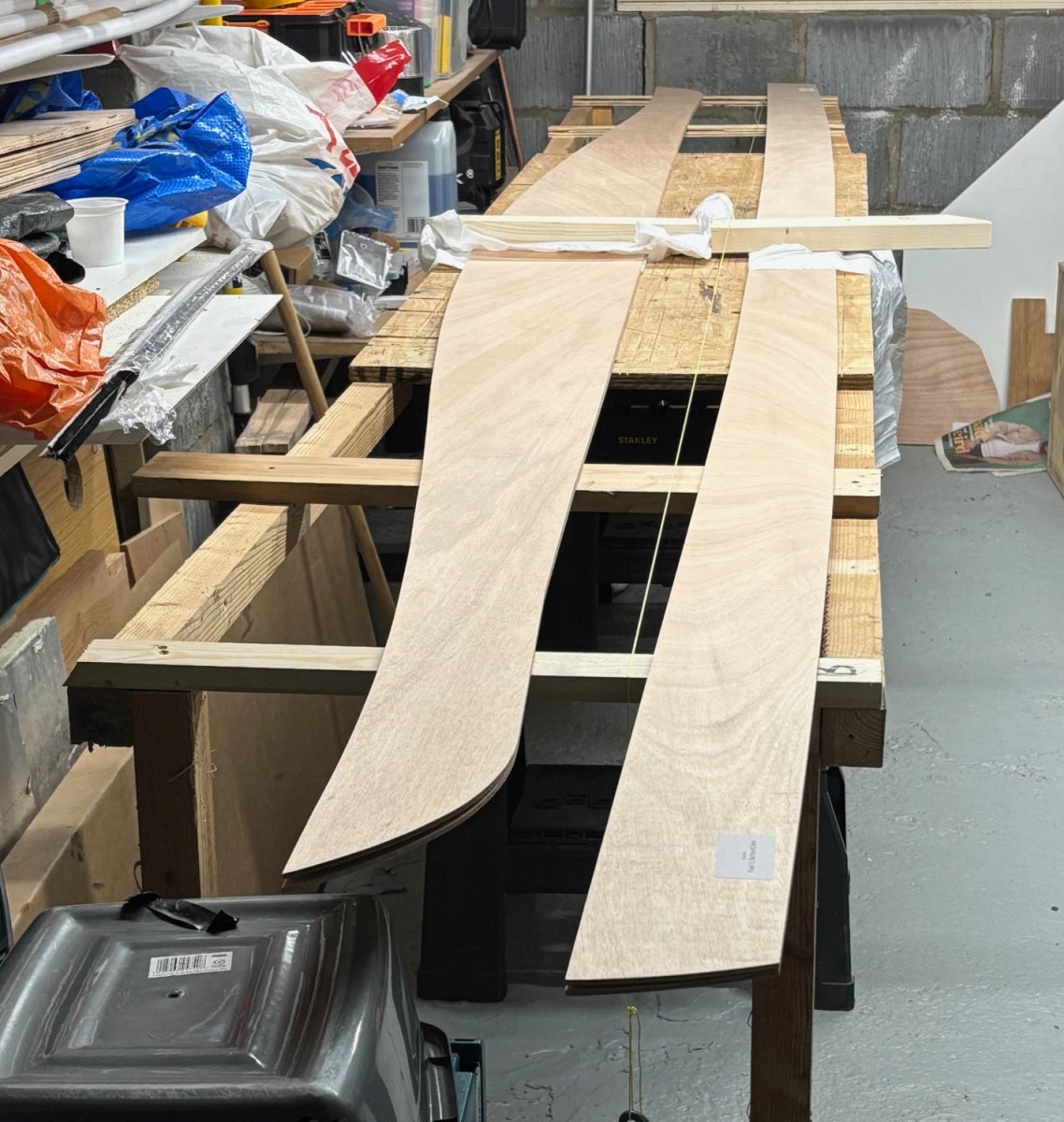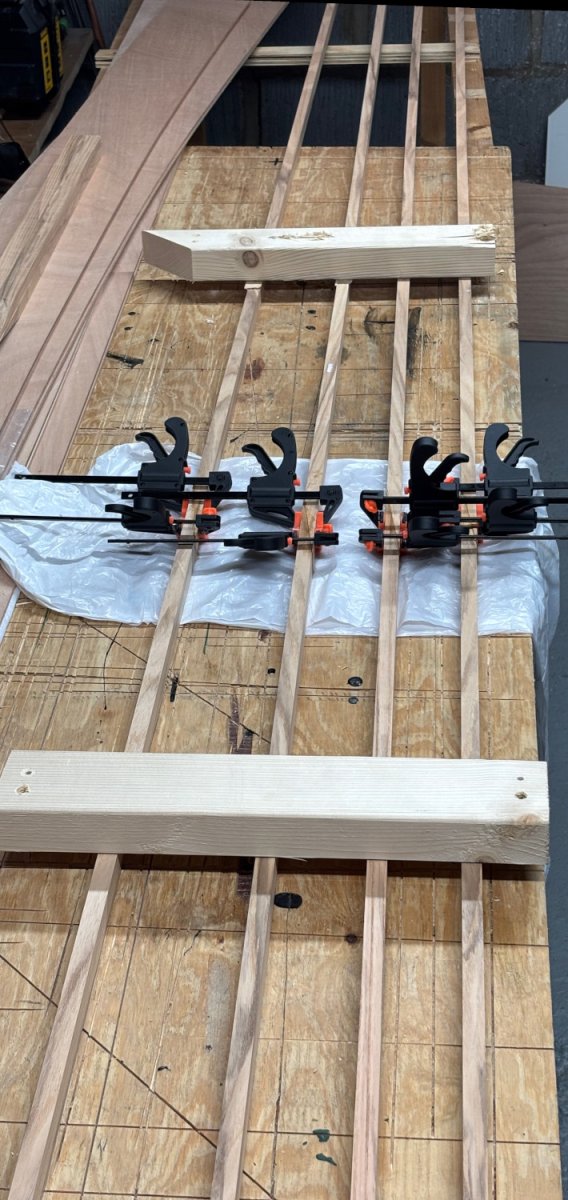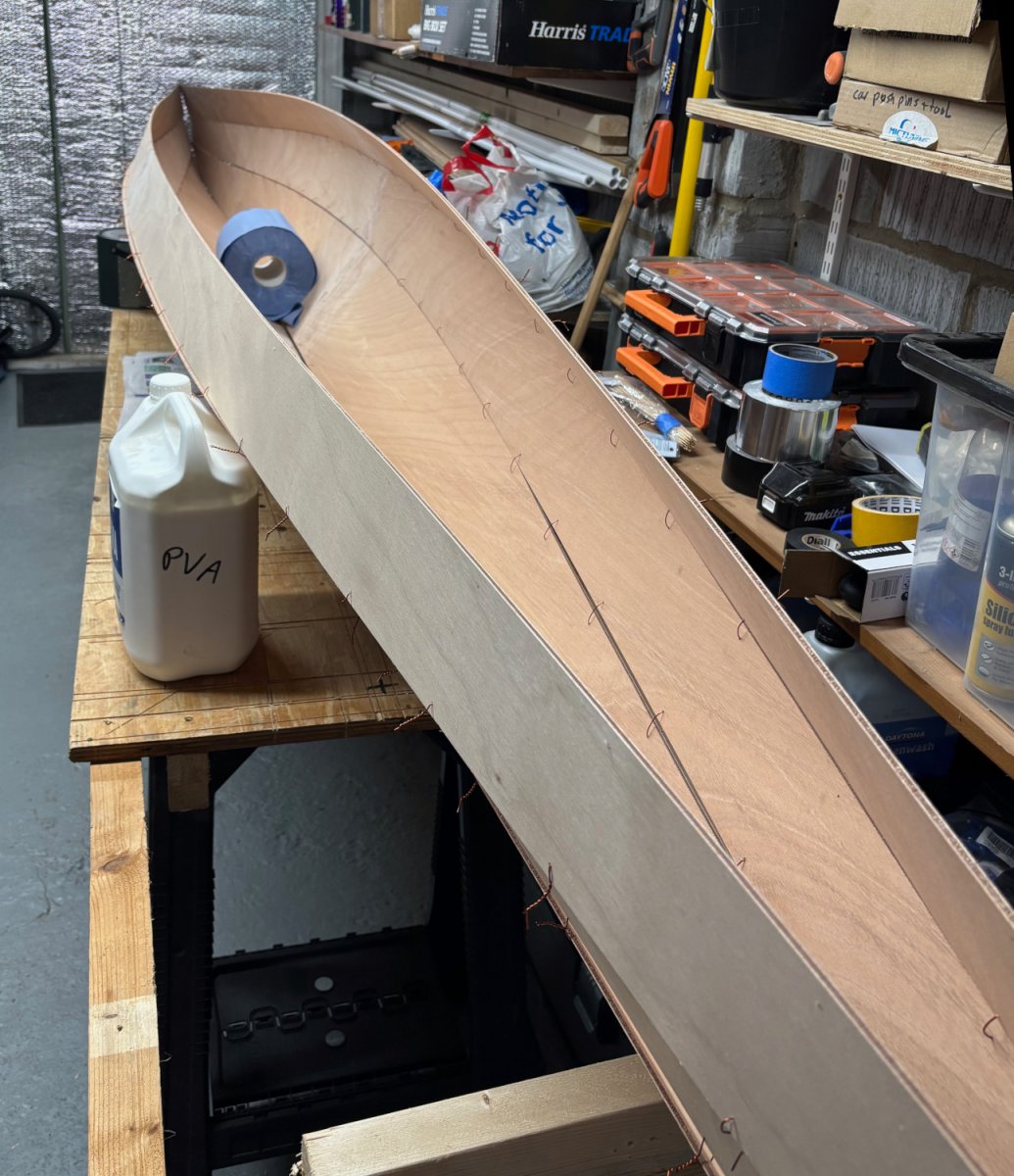You are not logged in.
- Topics: Active | Unanswered
Pages: 1
#1 8 Nov 2025 10:42 am
- cillian64
- Member
- Registered: 6 Nov 2025
- Posts: 3
Canadian Canoe build
Hello world. This winter I'm building the Canadian canoe from the kit, I'm documenting my progress in the hope that it will be helpful or encouraging to others. This might prove to be "interesting" given my garage is only 5.5m long and the finished canoe is 4.75m, but we'll see. This has the side-benefit of preventing me from procrastinating as the canoe will take up most of the garage so I can't really work on any other projects once I've gotten started. My goal is to be on the water when spring comes.
Everything arrived well-packaged and intact. I was initially feeling very confident as I've done a reasonable bit of woodworking before, but that quickly faded as I unpacked the box of very long, bendy pieces of wood.

Before getting going with the epoxy, I had a couple of side projects to complete. First, an extra-long workbench for gluing the puzzle joints. My normal portable workbench is two Stanley junior saw-horses (which have slots for 2x4s), with a piece of sacrificial 18mm shuttering ply screwed to the top. I extended this to about 4m long with some scrap wood I had lying around.

Next up, a hot-box for storing the epoxy. I'm not going to be able to keep my detached garage-workshop much warmer than about 10C in winter, so I thought I'd at least keep the epoxy warm. I made a small box out of spare ply scraps, insulated it with some PIR sheets and foil insulation, and added 2x 14W PTC reptile heating pads and an STC-1000 thermostat. I also added a zigbee temperature sensor, partly out of curiosity and partly because I don't really trust the thermostat. So far it seems to be working great!


Hopefully back later this weekend once I get the puzzle joints glued up.
Offline
#2 13 Nov 2025 9:00 am
- cillian64
- Member
- Registered: 6 Nov 2025
- Posts: 3
Re: Canadian Canoe build
I spent a while cleaning up the puzzle joints and ended up giving a quick sand round all the ply pieces to knock off the splinters. There were also a few tabs left from the CNC cutting, I found a small block plane a very satisfying way to remove those.
Aligning the joints, I was surprised how much movement there was overall despite the joints themselves feeling pretty tight. Checking alignment against the plans is definitely not optional. This is one place where my improvised workbench-with-end-extensions made things quite a bit harder than they needed to be - I'd recommend setting up a solid workbench the full length of the pieces if at all possible. I think I got away with a string-line and some careful sighting.

The epoxy is messier and trickier than I expected. Previously I've only used standard 5-minute epoxy, this stuff is a lot runnier (at least before thickening).

I'm pretty happy with how the joints have turned out. Some sanding required, but there aren't any voids or big protruding globs. The heated box seems to have done its job as the epoxy was rock hard in less than 24 hours despite the garage being pretty cold

Offline
#3 21 Nov 2025 4:35 pm
- cillian64
- Member
- Registered: 6 Nov 2025
- Posts: 3
Re: Canadian Canoe build
I'd been wavering over whether to glue together the gunwale/inwale pieces or wait until they were required as I'm rather short on storage space for long things. But, I decided it would be better to glue them while I still had my long flat workbench available. It took me a while to figure out the purpose of each length of ash - I had been expecting three equal pieces for each gunwale, but actually they were each two long pieces and one much shorter piece. Also, the peices for all four of the rails (port/starboard, gunwale/inwale) are identical as far as I can tell.
This is where I learned a rather important lesson: Just because your workspace is long enough to fit the finished boat, it's not necessarily long enough to fit the intermediate pieces. The gunwales follow a curve around the finished boat so are rather longer than it when they are straight (the build manual says 5.5m, versus 4.75m for the canoe. My garage is about 5.4m long). I decided to glue the two long pieces and leave off the short piece (this results in something like 5m) for now. Once I have the hull together I can work out what length I actually need - I'm hoping the 5.5m is somewhat oversized, and if not I'll have to do some of it outside or with the doors open. Hanging the rails from the ceiling worked very well to store them for now.
Anyway, gluing the rails went smoothly, I found it very useful to use two cauls to constrain the rails in one axis and stop the joints slipping lengthways when I clamp them - the rails are bendy enough to open the joint for glue and clamp it closed again. I bought a large number of very cheap clamps from aliexpress: they are surprisingly small and not especially strong, but ideal for this sort of thing.

Once those dried, I had to clean up the puzzle joints. A mouse-style detail sander (with dust extraction!) made relatively quick work of this. I thought I was using 120-grit paper but actually it was 80-grit. I'm not sure I'd recommend this but I think I got away with it - helpfully the marine ply doesn't seem to have the super thin veneers you get on most ply these days.

And then on to assembling and wiring the hull. My assistant was sadly busy (and didn't fancy the pretty cold garage) so I ended up doing this all solo. It was a little tricky but I was helped by my cramped space (the shelves stopped pieces flopping too far) and it went pretty well in the end. I deviated from the instructions by starting with a tie on each end and one in the middle then filling in the rest, rather than working along from one end - again, I seem to have gotten away with it. Here it is pre-bulkheads looking rather kayak-like:

And after I wedged in the bulkheads it suddenly popped into a much more canoe-like shape. I was pretty pleased with my trick of using 4 clamps and 2 blocks of wood to hold the central bulkhead in place, but now I look at the photo I realise I'd probably be better off adding a strap (like in the photos in the build manual) to hold the sides tight against the bulkhead.
I've started wiring in the end-bulkheads and trying to fine-tune the shape and tighten ties. So far this is being very tricky - the side pieces really want to slip past each other and overlap at the joints. More experimentation is required (I'm all ears if anyone has tips for this stage).

Offline
#4 25 Nov 2025 7:10 am
- Paul
- Employee

- From: Gatebeck Cumbria
- Registered: 4 Aug 2011
- Posts: 133
Re: Canadian Canoe build
It is difficult to tell from the picture how the boat is supported but it should be supported only near the ends at this stage: this makes it easier to fit the panels together since they will be fall into the correct place.
The ties do not need to be tightened until the panels are in the correct place. Tightening just one loop will prevent the panel moving down its entire length. Pull the panels so that they are together before tightening the loop: using the wire to pull the panels together will damage the wood.
Please don’t be tempted to cut any panel. The panels are cut to size and do fit together.
Offline
Pages: 1
